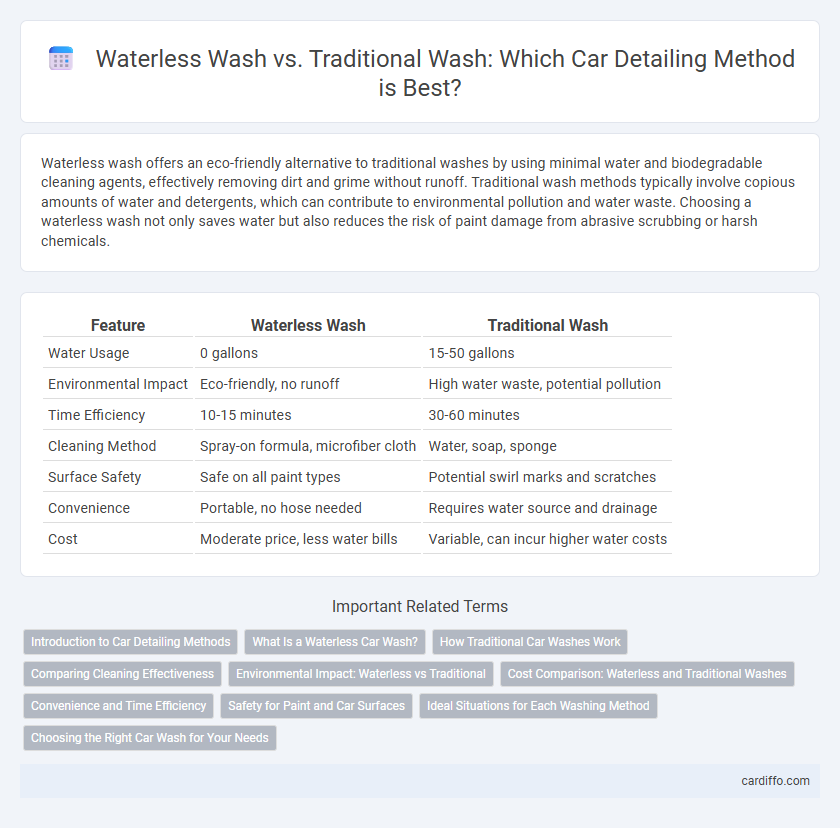Waterless wash offers an eco-friendly alternative to traditional washes by using minimal water and biodegradable cleaning agents, effectively removing dirt and grime without runoff. Traditional wash methods typically involve copious amounts of water and detergents, which can contribute to environmental pollution and water waste. Choosing a waterless wash not only saves water but also reduces the risk of paint damage from abrasive scrubbing or harsh chemicals.
Table of Comparison
| Feature | Waterless Wash | Traditional Wash |
|---|---|---|
| Water Usage | 0 gallons | 15-50 gallons |
| Environmental Impact | Eco-friendly, no runoff | High water waste, potential pollution |
| Time Efficiency | 10-15 minutes | 30-60 minutes |
| Cleaning Method | Spray-on formula, microfiber cloth | Water, soap, sponge |
| Surface Safety | Safe on all paint types | Potential swirl marks and scratches |
| Convenience | Portable, no hose needed | Requires water source and drainage |
| Cost | Moderate price, less water bills | Variable, can incur higher water costs |
Introduction to Car Detailing Methods
Waterless wash uses specially formulated detergents and lubricants to safely clean vehicle surfaces without water, effectively removing dirt and grime while minimizing environmental impact. Traditional wash relies on high-pressure water, soap, and brushes to clean the car but often consumes large amounts of water and can cause swirl marks if not performed correctly. Both methods have unique benefits, with waterless wash offering convenience and eco-friendliness, while traditional wash provides a thorough rinse for heavy dirt and road salt removal.
What Is a Waterless Car Wash?
A waterless car wash uses specially formulated cleaning solutions that encapsulate dirt and grime, allowing it to be wiped away without the need for water. These products are designed to protect a vehicle's paint while providing a quick and eco-friendly cleaning alternative. Waterless washes conserve thousands of gallons of water annually compared to traditional methods, making them ideal for water restrictions and environmental sustainability.
How Traditional Car Washes Work
Traditional car washes operate by applying large volumes of water combined with specialized detergents that break down dirt and grime on the vehicle's surface. High-pressure water jets and mechanical brushes or cloth strips physically remove contaminants, while rinse cycles flush away loosened debris. This method relies heavily on water usage and generates wastewater that requires proper treatment to prevent environmental harm.
Comparing Cleaning Effectiveness
Waterless wash products use advanced polymers and surfactants to lift dirt and grime without water, providing effective cleaning for light to moderate dirt. Traditional washes utilize high-pressure water and strong detergents to remove heavy contaminants, offering deeper cleaning for stubborn stains and embedded debris. Studies show waterless washes conserve up to 90% more water while maintaining comparable cleaning performance for everyday vehicle maintenance.
Environmental Impact: Waterless vs Traditional
Waterless wash techniques reduce water consumption by up to 90%, significantly minimizing runoff pollution and conserving freshwater resources compared to traditional washing methods. Traditional car washes typically use 30 to 50 gallons of water per vehicle, generating wastewater that may contain detergents and pollutants harmful to aquatic ecosystems. Embracing waterless wash products reduces environmental degradation by cutting emissions associated with water treatment and limiting chemical discharge into natural habitats.
Cost Comparison: Waterless and Traditional Washes
Waterless washes typically cost between $10 to $25 per treatment, offering a more economical option by reducing water usage and labor time compared to traditional washes, which average $15 to $50 depending on vehicle size and service location. Traditional washes require large amounts of water usage, often exceeding 40 gallons per wash, resulting in higher utility costs and environmental impact. Over time, waterless washes can deliver significant savings for eco-conscious consumers by minimizing water consumption and eliminating the need for expensive equipment and infrastructure.
Convenience and Time Efficiency
Waterless wash offers superior convenience by eliminating the need for hoses, buckets, and access to water sources, significantly reducing setup and cleanup time compared to traditional washing methods. This method allows for quick, on-the-go cleaning, ideal for busy schedules and urban environments where water restrictions may apply. Traditional wash, while thorough, demands more time and resources, making waterless wash a more efficient choice for maintaining vehicle appearance without lengthy interruptions.
Safety for Paint and Car Surfaces
Waterless wash products use advanced cleaning agents and lubricants that minimize the risk of scratching or damaging paint compared to traditional wash methods relying on water and abrasive sponges. Traditional car washes often expose surfaces to contaminants and grit that can embed in cloth or brushes, increasing the chance of swirl marks and paint degradation. Waterless wash solutions enhance safety for delicate finishes by encapsulating dirt particles and allowing for easy removal without harsh scrubbing, preserving the car's surface integrity.
Ideal Situations for Each Washing Method
Waterless wash is ideal for lightly soiled vehicles in urban environments where water restrictions or conservation efforts are in place, providing a quick and eco-friendly cleaning solution. Traditional wash suits heavily soiled cars or situations involving mud and grime, offering thorough cleansing through the use of water, soap, and rinsing. Choosing the appropriate method depends on vehicle condition, environmental regulations, and access to water resources.
Choosing the Right Car Wash for Your Needs
Waterless wash uses eco-friendly, biodegradable solvents to lift dirt without water, reducing environmental impact and suitable for lightly soiled vehicles. Traditional wash involves water, soap, and brushes for deep cleaning, ideal for heavy grime and residue. Selecting the right car wash depends on factors like vehicle condition, environmental concerns, and convenience preferences.
Waterless Wash vs Traditional Wash Infographic

 cardiffo.com
cardiffo.com